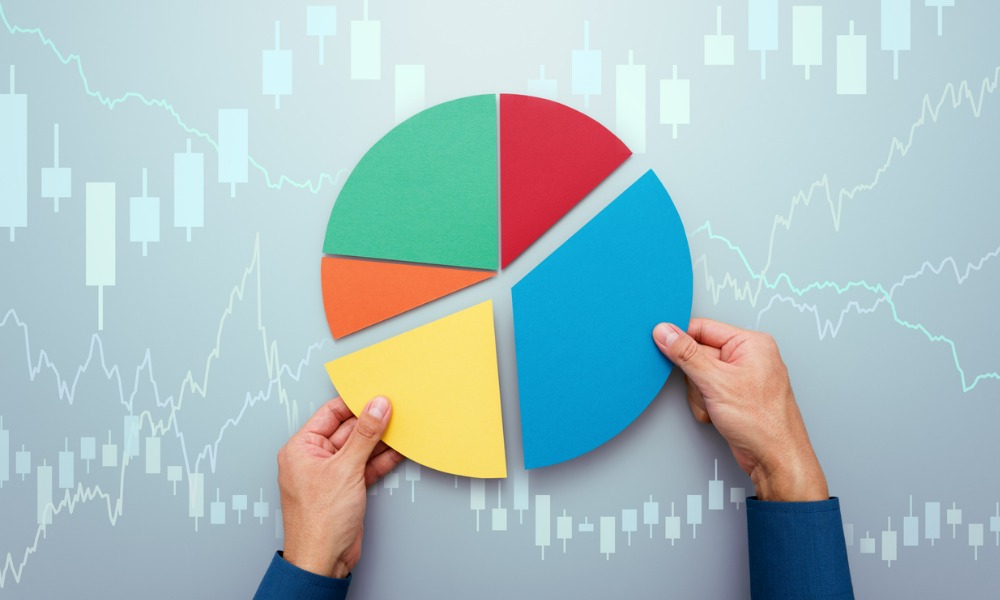Vanguard Canada leader unravels 2023 inflow trends across asset classes, and reaffirms the value of long-term perspective

While 2022 presented a unique challenge for investors as rapidly rising rates crushed the 60-40 portfolio, the pendulum swung drastically for the traditional balanced portfolio in 2023 – though many investors missed out.
“We saw a complete reversal in 2023,” Salvatore D’Angelo, head of Product for Vanguard Americas told Wealth Professional. “The Canadian home-biased 60-40 portfolio ended the year with a 12.5 % return.”
That annual performance – which included the best monthly return for the 60-40 portfolio in the past five years, according to D’Angelo – represents a remarkable comeback for the balanced portfolio. But a lot of investors weren’t around for the rebound, he says, as the promise of a 5% return on cash enticed them to sell out of the strategy.
“Looking at the past year, we saw strong returns from all parts of the portfolio – across bonds and stocks,” he says.
Those returns, D’Angelo notes, came despite a backdrop of volatility last year, including turbulence from the ongoing impact of interest rates and the US regional banking crisis in the first quarter. Even in the last half, he says, bond yields rose and touched 5% by early Q4, after which they rallied sharply downwards, providing a heavy boost to bond returns in the fourth quarter.
Focusing on investor flows, he says 2023 marked yet another year of strength for ETFs and passive strategies in general. While year-end figures for mutual funds have yet to come in, he says Canada-listed passive ETFs finished strong, taking in $38 billion in inflows.
“That’s a trend we’ve seen for multiple years excluding 2021, which was a record year for mutual funds,” D’Angelo said. “Broadly, we saw healthy adoption of ETFs for low-cost investing, whether that’s active or passive.”
Surveying trends across asset classes, he says fixed income and money market funds dominated inflows. In a dynamic that was somewhat carried over from 2022, he says an estimated 55% of inflows into all ETFs went into fixed income and money market strategies, with the latter taking in around 25% of total flows.
“Later on in the year, I think clients saw yields maybe peaking, and they got more comfortable with the picture on inflation and monetary policy,” he says. “They started to extend duration throughout the year, and we saw more flows into longer-dated bonds and more investors getting out of the money market, though there were still pretty strong flows into money markets consistently throughout the year.”
Equities turned out to be an interesting story, he says, as investors displayed an uncharacteristically low appetite for passive US equity funds. All told, he says $650 million flowed into US equities, whereas the lion’s share of flows going into Canada and ex-US equity strategies.
“That lines up with Vanguard’s views … We do see more potential for higher returns in ex-US markets, whereas we feel valuations are far stretched in the US," he says.
2023 also saw major movements into thematic strategies, particularly covered-call and option-based ETFs. Recognizing their appeal for yield-seeking investors, D’Angelo says they also come with a cap on the upside, making them a poor fit for investors primarily aiming for long-term wealth accumulation.
“If you’re a long-term investor who can manage through the volatility and you don’t need the income, a plain-vanilla passive core ETF may be better in the long run,” he says. “That’s especially true when you factor in the drag from higher costs, which you’ll see in a lot of these covered-call and option-based ETFs.”
After a challenging 2022, D’Angelo says Asset Allocation ETFs saw $3 billion in inflows in 2023. That’s not tremendous on an absolute basis, he says, but still notable as it represented an estimated 15% of starting AUM.
While investors may question the relevance of passive strategies moving forward, D’Angelo argues they are generally reliable all-weather, long-term investment options in the long run as they’re expected to match the returns of the market. Their low costs, he adds, gives them even more of an edge over higher-cost active funds in the long run.
Aside from their textbook application for buy-and-hold investors, D’Angelo says passive funds can also be used in active portfolio management, with advisors using low-cost, liquid passive ETFs to express their views.
“Passive strategies are often used to drive active decisions, because we know asset allocation is the biggest determinant of variability of returns,” he says. “You don't need to rely only on security selection, or having a view of which stocks will do better. It's really about making those asset allocation decisions, and ETFs are increasingly being used to do that.”
Have a story idea or suggestion? Email [email protected].



